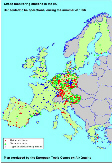2
AVAILABILITY OF DATA
According to the Directive, exceedances of
the population information and warning thresholds are to be
transmitted to the Commission within one month following the
observation. On basis of the experience gained with the ozone
data reporting in 1995, the Commission updated the formats to be
used and gave additional guidelines to ensure successful
transmission of data [5]. In this report, the definition of data
formats as described in the above mentioned guideline document is
used as reference. If necessary, files were converted at the
European Topic Centre on Air Quality (ETC-AQ) for further
processing. In this report all data received by The Commission
(DGXI) and forwarded to the ETC-AQ not later then 15 September
1996 have been included in the analysis.
For all 15 EU Member States, information
concerning the observation of exceedances during the months
April-July 1996 is available. Only for Spain, no information for
July has been received in time for this report. Table 2 presents
an overview of observed exceedances per country per month.
Table 2: Overview of observed
exceedances per month per country. yes: exceedance of the
population information threshold reported, no: no exceedance
reported, ?: no reporting received.
| AT
|
yes |
yes |
yes |
no |
| BE
|
no |
no |
yes |
yes |
| DE
|
yes |
yes |
yes |
yes |
| DK
|
no |
no |
yes |
no |
| ES
|
yes |
yes |
yes |
? |
| FI
|
no |
no |
yes |
yes |
| FR
|
yes |
yes |
yes |
yes |
| GB
|
no |
yes |
yes |
yes |
| GR
|
yes |
yes |
yes |
yes |
| IE
|
no |
no |
no |
no |
| IT
|
yes |
yes |
yes |
yes |
| LU
|
no |
no |
yes |
no |
| NL
|
no |
no |
yes |
yes |
| PT
|
no |
no |
yes |
yes |
| SE
|
yes |
yes |
yes |
no |
|
Member States were requested to check the
information made available to the Commission on ozone monitoring
sites implemented in the framework of the Directive. For the
interpretation of ozone data it is essential to have information
on the direct surroundings of the station since the ozone
concentration may be scavenged by locally emitted nitrogen oxides
or by enhanced dry deposition which might occur for exmaple under
a forest canopy. Member States were requested to classify their
stations as street, urban background or rural stations as a first
description of the environment of the stations. Map 1 presents
the location of all ozone monitoring stations (street and urban
background taken together as 'urban') which were scheduled to be
operational during the 1996 summer season, based on the
information supplied by the Member States. 1012 ozone monitoring
sites are operational in the framework of the Directive. This
amounts to an increase of 154 stations since 1995. From the 1012
ozone monitoring stations, 272 stations are situated in rural
areas, 283 stations in urban background environments, 163 are
street stations and for 294 stations the monitoring environment
was not specified.
Note that due to the fact that since only
exceedances of thresholds were reported, it is not clear that
stations were operational continuously. It is possible that ozone
concentrations exceeded a threshold at a site but was not
reported because the monitoring station was temporarily out of
operation.
In this report exceedances are counted on a
daily basis, that is, a day on which a threshold is exceeded at
least once, is calculated as one exceedance day. Note that
information presented in this document is not necessarily based
on validated monitoring data and hence should be considered
preliminary.
 |
Map
1: Ozone monitoring
stations implemented in the framework of Directive
92/72/EEC on air pollution by ozone, scheduled to be
operational during 1996. |


Document Actions
Share with others